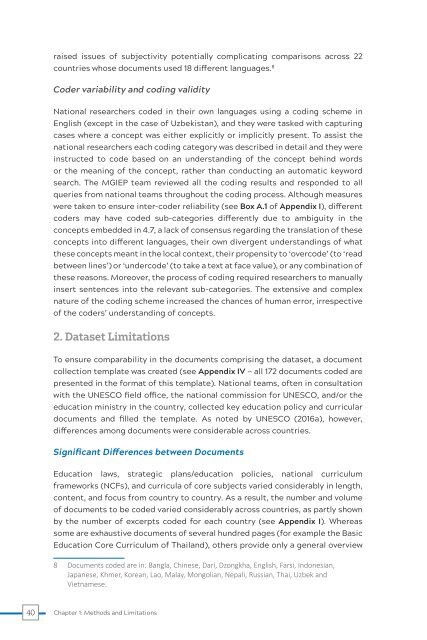Rethinking Schooling for the 21st Century
UNESCO MGIEP officially launched 'Rethinking Schooling for the 21st Century: The State of Education, Peace and Sustainable Development and Global Citizenship' in 2017 at the UNESCO General Conference. This study analyses how far the ideals of SDG 4.7 are embodied in policies and curricula across 22 Asian countries and establishes benchmarks against which future progress can be assessed. It also argues forcefully that we must redefine the purposes of schooling, addressing the fundamental challenges to efforts to promote peace, sustainability and global citizenship through education.
UNESCO MGIEP officially launched 'Rethinking Schooling for the 21st Century: The State of Education, Peace and Sustainable Development and Global Citizenship' in 2017 at the UNESCO General Conference. This study analyses how far the ideals of SDG 4.7 are embodied in policies and curricula across 22 Asian countries and establishes benchmarks against which future progress can be assessed. It also argues forcefully that we must redefine the purposes of schooling, addressing the fundamental challenges to efforts to promote peace, sustainability and global citizenship through education.
You also want an ePaper? Increase the reach of your titles
YUMPU automatically turns print PDFs into web optimized ePapers that Google loves.
aised issues of subjectivity potentially complicating comparisons across 22<br />
countries whose documents used 18 different languages. 8<br />
Coder variability and coding validity<br />
National researchers coded in <strong>the</strong>ir own languages using a coding scheme in<br />
English (except in <strong>the</strong> case of Uzbekistan), and <strong>the</strong>y were tasked with capturing<br />
cases where a concept was ei<strong>the</strong>r explicitly or implicitly present. To assist <strong>the</strong><br />
national researchers each coding category was described in detail and <strong>the</strong>y were<br />
instructed to code based on an understanding of <strong>the</strong> concept behind words<br />
or <strong>the</strong> meaning of <strong>the</strong> concept, ra<strong>the</strong>r than conducting an automatic keyword<br />
search. The MGIEP team reviewed all <strong>the</strong> coding results and responded to all<br />
queries from national teams throughout <strong>the</strong> coding process. Although measures<br />
were taken to ensure inter-coder reliability (see Box A.1 of Appendix I), different<br />
coders may have coded sub-categories differently due to ambiguity in <strong>the</strong><br />
concepts embedded in 4.7, a lack of consensus regarding <strong>the</strong> translation of <strong>the</strong>se<br />
concepts into different languages, <strong>the</strong>ir own divergent understandings of what<br />
<strong>the</strong>se concepts meant in <strong>the</strong> local context, <strong>the</strong>ir propensity to ‘overcode’ (to ‘read<br />
between lines’) or ‘undercode’ (to take a text at face value), or any combination of<br />
<strong>the</strong>se reasons. Moreover, <strong>the</strong> process of coding required researchers to manually<br />
insert sentences into <strong>the</strong> relevant sub-categories. The extensive and complex<br />
nature of <strong>the</strong> coding scheme increased <strong>the</strong> chances of human error, irrespective<br />
of <strong>the</strong> coders’ understanding of concepts.<br />
2. Dataset Limitations<br />
To ensure comparability in <strong>the</strong> documents comprising <strong>the</strong> dataset, a document<br />
collection template was created (see Appendix IV — all 172 documents coded are<br />
presented in <strong>the</strong> <strong>for</strong>mat of this template). National teams, often in consultation<br />
with <strong>the</strong> UNESCO field office, <strong>the</strong> national commission <strong>for</strong> UNESCO, and/or <strong>the</strong><br />
education ministry in <strong>the</strong> country, collected key education policy and curricular<br />
documents and filled <strong>the</strong> template. As noted by UNESCO (2016a), however,<br />
differences among documents were considerable across countries.<br />
Significant Differences between Documents<br />
Education laws, strategic plans/education policies, national curriculum<br />
frameworks (NCFs), and curricula of core subjects varied considerably in length,<br />
content, and focus from country to country. As a result, <strong>the</strong> number and volume<br />
of documents to be coded varied considerably across countries, as partly shown<br />
by <strong>the</strong> number of excerpts coded <strong>for</strong> each country (see Appendix I). Whereas<br />
some are exhaustive documents of several hundred pages (<strong>for</strong> example <strong>the</strong> Basic<br />
Education Core Curriculum of Thailand), o<strong>the</strong>rs provide only a general overview<br />
8 Documents coded are in: Bangla, Chinese, Dari, Dzongkha, English, Farsi, Indonesian,<br />
Japanese, Khmer, Korean, Lao, Malay, Mongolian, Nepali, Russian, Thai, Uzbek and<br />
Vietnamese.<br />
40<br />
Chapter 1: Methods and Limitations

















